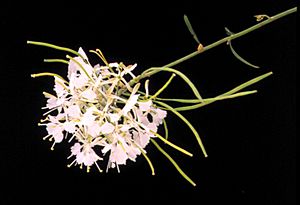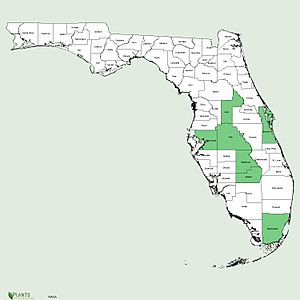Carter's pinelandcress facts for kids
Quick facts for kids Carter's pinelandcress |
|
|---|---|
 |
|
| Conservation status | |
| Scientific classification | |
| Genus: |
Warea
|
| Species: |
carteri
|
 |
|
| Warea carteri distribution | |
The Warea carteri is a special plant in the mustard family. People often call it Carter's pinelandcress or Carter's mustard. This plant is an annual, meaning it lives for only one year. It grows in central Florida in the United States, especially in dry, shrubby areas called the Lake Wales Ridge. It is an endangered species, which means it's at risk of disappearing forever. This plant also depends on wildfires to grow and spread.
Contents
About the Carter's Pinelandcress
The Carter's pinelandcress is a herb that can grow from about 0.2 to 1.5 meters tall. It has green stems that stand straight up. These plants usually have many thin branches that spread out, making them look like an open, rounded bush.
Leaves and Flowers
The leaves of the plant are arranged one after another on the stem. The lower leaves usually fall off by the time the plant starts to flower. The size and shape of the leaves change depending on how old they are and where they are on the plant. Leaves near the tips of the stems are smaller and narrow, while those closer to the bottom are larger.
The Warea carteri has many flower clusters that are dense and rounded. Each cluster can have 60 or more flowers! These flowers are round and have four white sepals (leaf-like parts that protect the bud) and four white petals. The petals are about 6 millimeters long. The flowers also have six stamens (the male parts) that produce nectar. The ovary (the part that becomes the fruit) is at the top of a slender stalk.
How it Makes Fruit
The Warea carteri plant is special because its male parts (stamens) become ready before its female parts (stigmas). This helps with pollination. The plant's fruit is a long, thin pod called a silique. This pod is about 4 to 6 centimeters long and holds many small, oblong seeds. When the fruit dries, it splits open to release the seeds.
Plant Family and Names
The Warea carteri was first named by a scientist named Small in 1909. Later, in 1964, a review of the plant group confirmed Small's naming. This plant doesn't have other scientific names. Besides Carter's pinelandcress, it's also known as Carter's warea or Carter-warea.
Where it Lives
Historically, W. carteri was found in scrubby areas and sandhills on the Lake Wales Ridge in Highlands, Polk, and Lake counties in Florida. It was also found in Miami-Dade County and Brevard County.
Today, this plant is mostly found in Highlands, Polk, and Lake counties on the Lake Wales Ridge in central Florida. Some of the places it used to grow, especially along Florida's Atlantic coast, might now be developed with buildings.
Its Home Environment
The two biggest groups of W. carteri plants on the Lake Wales Ridge are at the Archbold Biological Station and The Nature Conservancy's Tiger Creek Preserve.
At Archbold Biological Station, W. carteri grows in scrubby flatwoods and sandhills that have many Turkey Oak trees. It's often found where these two types of plant areas meet. Since sandhills have yellow sand, you'll often find W. carteri in or near yellow sandy spots. Some groups of these plants at Archbold Biological Station are even next to roads or in areas where people have disturbed the land in the past.
At Tiger Creek Preserve, W. carteri is found in similar areas, including scrubby flatwoods and dry hammocks. In Miami-Dade County, it was found in South Florida Slash Pine forests.
How it Reproduces
Scientists have learned that Warea carteri can pollinate itself. This means that even if a plant is alone, it can still make seeds. This is very helpful for plants that are spread out or isolated.
Pollination and Seeds
Even though it can self-pollinate, insects are very important for this plant to make lots of fruit and seeds. Many different insects visit the flowers, including native bees, bumblebees, hoverflies, wasps, flies, and beetles. When insects move around on the same plant, it often leads to self-pollination.
The seeds of W. carteri are not spread by wind or animals in any special way. They just drop to the ground when the fruit dries and splits open.
Life Cycle
The seeds of W. carteri usually start to sprout in late winter or early spring (January to March). The plants then flower in September and October. They produce fruit in October and November, and the seeds are released in November and early December.
Scientists have found that the seeds need moisture and light to sprout. Some seeds can stay dormant (asleep) in the ground for at least two years. This means that even if you don't see plants above ground, there might still be seeds waiting to grow.
Plant Neighbors
Warea carteri often grows in dry oak areas where other rare scrub plants are not common. It can also be found where scrub and high pineland meet, alongside plants like scrub buckwheat and scrub plum.
This plant doesn't seem to suffer much from being eaten by animals or insects. Sometimes, a small number of plants might get a mold or fungus. Scientists haven't studied how W. carteri competes with other plants. It's not clear if the lack of plants in areas that haven't had a recent fire is due to other plants taking over, or if fire itself is needed for the seeds to sprout.
Its Endangered Status
Warea carteri was listed as an endangered species in 1987. This was mainly because its habitat (the place where it lives) was being destroyed.
Threats to the Plant
The biggest dangers to W. carteri are:
- Habitat destruction: On the Lake Wales Ridge, many of the plant's homes are being turned into farms (like citrus groves) or places for people to live. A lot of the natural scrub land in Florida has already been lost.
- Fire suppression: For many years, people have tried to stop wildfires. But W. carteri needs fire to grow and reproduce well. Without fire, its populations get much smaller.
The plant has likely disappeared from Miami-Dade County and Brevard County because almost all of its natural habitat there has been developed into cities.
Population Changes
Scientists have been watching the two largest groups of W. carteri in central Florida. They've noticed that the number of plants changes a lot from year to year. The data shows a strong link between the plant's population and fire.
W. carteri populations usually grow quickly and strongly after a fire. You'll see many more plants appear or boom one year after a fire. But then, the populations often crash (meaning many plants disappear) two years after a fire. In places where fires have been stopped for a long time, the plants usually only survive in very small numbers.
Protecting the Plant
Fires are a natural part of the environment where W. carteri lives. Depending on the type of scrub, fires might happen every 2 to 20 years. Scientists are learning that using controlled fires is a very important way to keep large groups of this plant alive.
Conservation Efforts
Just like with other rare species, protecting the habitat of W. carteri is key to its survival. Even without fire, some small groups of W. carteri have survived in disturbed areas, like next to roads.
It's hard to monitor Warea carteri because it's an annual plant and can stay hidden as seeds for several years. You might only see many plants growing and flowering in the first year after a fire. Also, the plant is only easy to spot during its short flowering period, which lasts about a month. This makes it difficult to find all the places where it lives.
Because of these challenges, it's important to understand that if you search for W. carteri at a site for only one year, you might not find any plants, even if they are there as dormant seeds. Proper fire management is crucial to prevent the loss of seeds from the seed bank and to keep the populations healthy.
Images for kids



